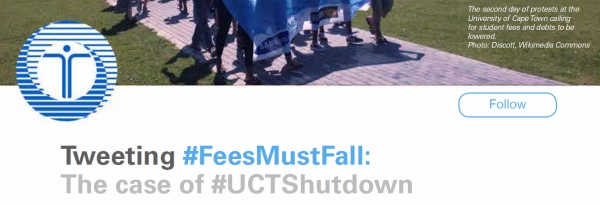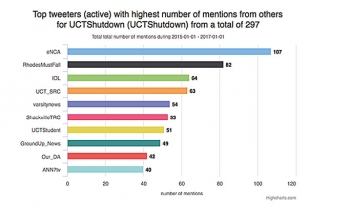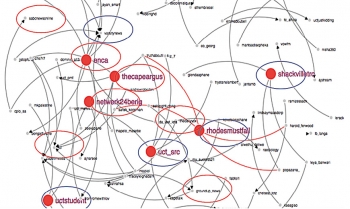Tweeting#FeesMustFall: The case of #UCTShutdown
Resistance against neoliberal higher education policies is a global student concern. In South Africa, the effect in the university sector has been a level of contentious student politics that is unprecedented in the post-apartheid era. This presentation by Assoc. Prof. Thierry M Luescher deals with #FeesMustFall-related Twitter activism by students at the University of Cape Town in 2015/2016.
Starting from Spring 2015, students across the country became engaged in the #FeesMustFall campaign, participating in protest action and shutting down university campuses. The nation-wide student movement initially halted tuition fee increases for 2016 and eventually resulted in a new national policy of free higher education for poor and working-class students in 2018.
Digital media has proved highly effective during protest events. Examples of this are the Arab Spring and the Occupy movements, as described by Yannis Theocharis from Mannheim University in Germany and others in 2014, and the Spanish sociologist, Manuel Castells in 2015. During the #FeesMustFall movement in South Africa, student activists, sympathisers and others used various social media platforms prolifically, particularly Twitter, Facebook and WhatsApp. However, apart from a limited number of pioneering studies, there is no systematic evidence of the cyber life of the new South African student movement. Therefore, as part of the HSRC project, The New South African Student Movement: From #RhodesMustFall to #FeesMustFall, we asked the question: “How did student activists use social media to further their protest action as part of the Fees Must Fall campaign?”
This conference presentation dealt with #FeesMustFall-related Twitter activism by students at the University of Cape Town (UCT). We analysed digital trace data from Twitter and interviews with UCT student activists to explore the way they used social media to further their protest action. This was based on the concept of ‘connective action’, i.e. the use of social media for the mobilisation of loose social movements, as conceptualised by Lance Bennett from the University of Washington and Alexandra Segerberg from Stockholm University in 2013. With the UCT campus- specific Fees Must Fall campaign, we identified the Twitter hashtag #UCTShutdown as the best proxy, compared to others like #UCTFees and #UCTFeesMustFall. The open- source platform Mecodify provided the tool for us to obtain 11,967 unique tweets, using the hashtag #UCTShutdown (98,065 including retweets) for 2015 and 2016. We conducted a social network analysis of this database, using the Mecodify tool, and the opensource social network analysis platform Kumu.
Table 1
Table 2
Mobilising the media and protest cows
From interviews with nine UCT student activists we learnt that Twitter was used as the primary public relations tool to represent the student movement’s perspective of unfolding events. They would assign live-tweeters to cover the protest events and tweet directly to public media houses, thereby relaying ground-up reports from protest events into the mainstream media. A secondary use of the platform was to mobilise sympathisers to join protest events and swell the numbers, as so-called ‘protest cows’, a term used by activists. Quotes from activist interviews include: “When something trends on Twitter, all media houses want to know what is happening and they want to get involved” and “Twitter is the best mobilising tool [for] protest cows to come and herd and just be in the masses”.
Figure 1
Our social network analysis of the hashtag #UCTShutdown corroborates the claims made by the activists. Table1 shows that most of the top 10 tweeting tweeters for #UCTShutdown were UCT- campus based (e.g. @varsitynews,@UCTLawStudents, @UCTMSA, @zeekabane, @RhodesMustFall). However, Table 2 shows that the top 10 tweeters with the highest numbers of mentions from others for #UCTShutdown included several key South African media houses, including @eNCA, @IOL, @ GroundUp_News, and @ANN7tv.
Visualising tweeter connections
Another way of illustrating this is by analysing the engagement links, or connectedness, between different tweeters, using replies and mentions, and by depicting these links with the Mecodify network visualisation tool. In Figure 1 we can clearly see the centrality of certain key players, including mainstream news organisations. These include @eNCA, @Netwerk24Berig, @TheCapeArgus, @SABCNewsOnline, @IOL, @thedailyvox, the UCT organisations @RhodesMustFall, @ShackvilleTRC, and @UCT_SRC, as well as UCT’s student newspaper @varsitynews, the most connected and central to information diffusion within the network.
Closer social-network analysis using Kumu revealed that, while students mostly used mainstream news organisations to place issues on the public and policy agenda, the local campus newspaper, varsitynews, played a key role as an information bridge within the network. The latter emerged as one of four key communities in the network, informal self-organising groups of users that share a particular practice or interest in a specific area and represent informal knowledge flows. A community emerges when the nodes of the network can be easily grouped into (sometimes overlapping) sets of nodes, such that each set of nodes is densely connected internally. Our analysis revealed a diffuse network of user communities tweeting with #UCTShutdown.
The four largest communities in the network (i.e. most connected users) centred on the following users: @Decolonialqueer (a UCT student activist), @RhodesMustFall (the Rhodes Must Fall movement’s handle), @eNCA and @varsitynews.
This highlights the emergence of, and potential of, higher-level organisation in crowd-enabled networks, as described by Segerberg and colleagues in 2014.
Conclusion
For our purposes, the social- network analysis of #UCTShutdown represents a pilot in the larger “From #RhodesMustFall to #FeesMustFall” project. As an initial analysis it shows how powerful social media analysis can be as a means to test a number of propositions. In this case, it corroborates student activists’ claims about Twitter as a PR and crowd-mobilisation tool and therefore the importance of Twitter in Fees Must Fall-related protest action. In theoretical terms, our work gives a glimpse into the online life of an internet-age, networked student movement. It also provides preliminary evidence for a further analysis of the proposition that Fees Must Fall was indeed a case of a crowd-enabled network, whereby multiple individual users, user communities and networks become ‘stitched’ into a larger movement in which technology-enabled communication is organisation.
Authors: Assoc. Prof. Thierry M Luescher, research director, and Nkululeko Makhubu, a master’s intern, in the HSRC’s Education and Skills Development programme; and Assoc. Prof. Tanja Bosch, from the Centre for Film and Media Studies at the University of Cape Town.
tluescher@hsrc.ac.za




